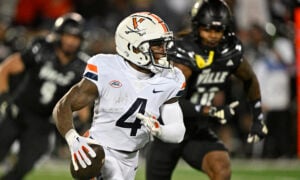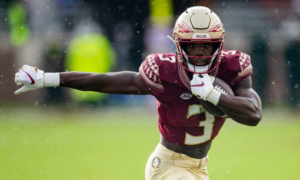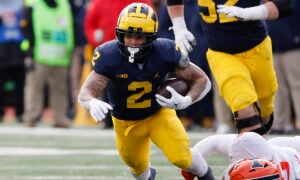If This, Then What? Los Angeles Chargers
If the Los Angeles Chargers don’t have Hunter Henry, who will Philip Rivers throw passes to?
When writing these articles, I try to highlight a situation in the NFL we are wondering about for 2018. If we are right about this, what can we expect to happen about that? Sometimes they are situations I don’t think we’re questioning enough, sometimes they are ones I think we are questioning too much. In this case, it’s something we know is a question, but I don’t think we’re highlighting the right details.
Essentially, I don’t think there are many more targets available, and the effect is likely to be distributed out throughout the offense. But, with the loss of Antonio Gates, and without Henry to step into the breach, there is something missing in the offense. So I took a dive into what we can expect from the offense, and look at who might be most likely to benefit from any holes in the depth chart.
Given what has happened before – and what we can expect from Philip Rivers in 2018 – who will produce more for the Chargers?
[am4show have=’g1;’ guest_error=’sub_message’ user_error=’sub_message’ ]
Opportunity lost
There are a few ways to look at the potential opportunity in 2018. One of the simplest is to see how many targets and rush attempts are missing based on last season and the players who have left the team. Hunter Henry had 81 targets in 2017. And while there was a general assumption that would see an increase in role in 2018, that doesn’t mean that same role is available now he’s gone.
If we remove Hunter Henry as well as Gates and every other player who is no longer available on the Chargers in 2018, here is the opportunity they have lost from their 2017 season.

*Data used is from fantasyadhd.com and ffstatistics.com
You can see more about this and results from every team in my Opportunity Lost Tool here: https://docs.google.com/spreadsheets/d/1IoJxSTgJ5VhT0E9xJeNWrG2rWCl-PebURhXD1P7m2ao/edit?usp=sharing
The Chargers rank 18th in targets lost from the 2017 season, for example. While it might be a decent chunk if it were given to any one player, that’s not what generally happens. More often targets are either left out the offense the next season or they are spread out over the depth chart. Either way, it’s not nearly enough opportunity to equal a decent workload for another player who wasn’t fantasy-viable already.
Philip Rivers Average
Instead of looking at the team, what if we focus on Rivers? He has a deep history of production, which offers us a rare chance to incorporate his own averages to projections. It may seem strange but when a player consistently produces over 4,300 passing yards for five years despite a number of injuries and changes, it’s safe to see that as his floor.
Here are the last five years of Rivers’ career and the average yards and touchdowns he has produced in that time.

*Data from ffstatistics.com
My idea is to take the 2017 target share for all players still on the roster, give them their average (or league average efficiency for those with less than two years of history in the NFL) and see how it compares to Rivers’ average production.
This should help us understand how much of anything is missing, based on a pretty sure floor for 2018.
So I took my projection model, isolated the Chargers team page and reduced it to just the passing game. I’ve tried to include all the needed context in this picture, so I apologize if it’s hard to take in or takes a second to fully read.
If I used the league average for efficiency (at the player’s position) I highlighted the number in red. Everything else is based on the target share each player had in 2017. I set the passing attempts to 570, safely under Rivers average, so this should offer us a conservative look at what the 2017 team, with the same opportunity, would produce in 2018 if everything remained static.

*Data for my projection model comes from a bunch of players including rotoviz.com’s Rotoscreener, ffstatistics.com, fantasyadhd.com, airyards.com, and pro-football-reference.com
You can make your own projections using my mini Projections model built using statistical data here: https://docs.google.com/spreadsheets/d/1cYnJcBIswo5E-H6uB6yxtAf3rsB9Z_S1F5vBMsESKCo/edit?usp=sharing
Now, let’s compare the results to the average in the previous picture.

Rivers would produce just fine compared to his average, even if he had a five year low in passing attempts, 570. True, his yards would be the lowest he’s seen since 2014. The completion percentage is clearly too optimistic at 68% compared to the last five years. However, as a conservative estimate, it looks in line with his career.
Except touchdowns.
Missing Touchdowns
This makes more and more sense the longer you think about it: If we stop thinking about the number of yards and targets we hoped Hunter Henry was going to get and start thinking about what the team has actually lost recently. The answer is really Antonio Gates.
We expected Hunter Henry, but it’s Gates’ production which is missing. He was a prolific touchdown machine and not much of a targets and yards player in the last few years. The Chargers are losing those touchdowns a lot more than they are the potential we hoped Henry had.
Now to be clear, I think Rivers can still produce more yards, and he probably will. I also think Keenan Allen’s target share of 27% is likely to drop in 2018. But based on my research I don’t think it’s likely to fall far enough to move a player from nothing to something, say Mike Williams.
Instead, the number of potential targets would only really have a fantasy impact if given to someone who already had targets, and was now about to see a vital red zone friendly bump.
So, I think it’s between Tyrell Williams and Travis Benjamin.
Here are the targets and target share in the red zone for every player who has had more than one target in the last five years for the Chargers.

*Data from ffstatistics.com
Allen has seen a significant target share inside the 20-yard line in 2017 and in 2013. He was inefficient with those targets last year, but he should still see a decent number. Based on his point production versus a three-year average (judged by where those targets came from inside the red zone), he produced 15 fewer fantasy points – or almost three touchdowns – less than he should have.
This is according to Red Zone Expected Value, explore here: https://docs.google.com/spreadsheets/d/1IZDYeQwxMAPLmVJDbvc0mBFd5Bi8KpFR0xNVhw4wG8g/edit?usp=sharing
Who to target?
Allen might lose targets, but he’ll still get more than anyone else. And he is due to some positive regression in touchdowns. He could/should still get extra targets in the red zone as well.
The losses of Henry and Gates could actually benefit Allen more than anyone else.
The next player still on the team to have a history of red zone work is, in fact, Tyrell Williams. His 2016 season, when Allen was injured, saw him claim the WR1 role on the team. He also saw a significant share of targets – similar to Allen’s – in the red zone.
Virgil Green has never had more than 4 targets inside the 20-yard line and has failed to score more than one touchdown in seven seasons in the NFL. I just can’t expect him to break out given the low likelihood of targets and such poor red zone history.
Tyrell Williams has been efficiency in two different roles for the chargers now. He was efficient when he stepped in for Allen in 2016 as the lead receiver. He’s also been good as a downfield, big-gain receiver since.

*Graph from DLF.com’s player page
According to DLF ADP, he is currently being drafted outside the top 150 players, and behind fourth-round rookie picks like D.J Chark. If he Tyrell gets the targets, it could propel his opportunity into greater fantasy relevance. Together with a potential for four-seven touchdowns in 2018, he is an easy value pick for 2018 based on upside.
Conclusion
Ultimately, I think Philip Rivers should throw for more attempts then 570, so there are more targets available than in our average. However, target share – which is more stable year-to-year then raw targets – could still be swallowed up the same way it happened in 2017. There is no need for another fantasy-relevant asset to emerge on this team.
However, with the loss of the team’s recent touchdown efficiency, there does seem to be the potential for missing touchdowns in 2018 based on 2017 usage. In other words, I think Keenan Allen’s positive touchdown regression is more likely to happen, but someone else will likely see a shift in red zone targets in 2018.
I think this makes Tyrell Williams a much more interesting target this year than previous years as he has had some history of a significant target share on this team – especially since there is no reason the target share has to shift enough to create a significant role for Mike Williams or Virgil Green.
If someone is to emerge outside of Allen, they will need to earn targets from him. But I don’t expect his target share to drop by very much. And if someone can emerge without Allen losing too many targets, it’s Tyrell Williams. But before I’m targeting him, I’m looking to snag Allen himself.
[/am4show]
- Peter Howard: Dynasty Fantasy Football Superflex Rankings Explained - March 6, 2024
- Dynasty Target and Regression Trends: Week 15 - December 23, 2023
- Dynasty Target and Regression Trends: Week 14 - December 16, 2023


































































